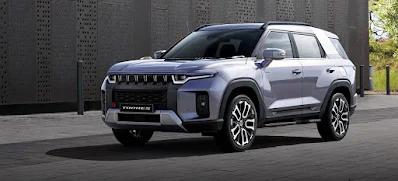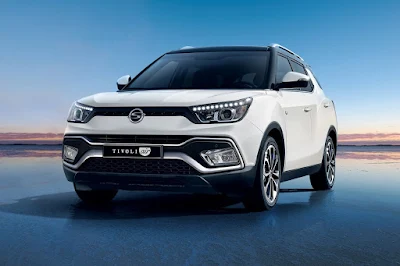In case you missed it, Ssangyong is officially dead and gone as South Korea's SUV specialist is now renamed KG MOBILITY. The renaming was made following the car company's takeover by the KG Group late last year. It's been a long time coming for those who are expressing stigma over the Ssangyong name in the world of motoring.
 |
| Launched in the summer of 2022, the Torres is the last vehicle to bear the Ssangyong banner. |
With the days of Ssangyong as a car company well and truly over as it now evolved into KG MOBILITY, it's time to jot down the cars that defined Ssangyong since it was renamed from Dong-A motor in the late 80s.
Korando Family (1988-1996) - The Korando Family is an SUV that is the first to don the Ssangyong banner ever since Dong-A Motor was taken over by the now-defunct Ssangyong group of companies. It's essentially a rebadged Isuzu Bighorn and it's powered by a wide range of diesel engines from 2.2L to 2.6L. It was given a minor change in 1992 and 1994 before it was discontinued in 1996.
Musso (1993-2005) - Launched in the summer of 1993, the Musso served as Korea's answer to the Jeep Grand Cherokee, Ford Explorer, and Toyota Land Cruiser. Styled by a Brit, powered by a Mercedes-Benz engine, and the only Korean SUV to conquer the Dakar Rally when it won the diesel class in 1996, it was known to be the offroading legend in Ssangyong's own right. Because of its partnership with Mercedes-Benz, some countries like the Philippines sold the Musso as a Mercedes-Benz. Production of the Musso ended in 2005.
New Korando (KJ, 1996-2005) - Launched in the summer of 1996, the KJ Korando features styling inspired by its KH-7 predecessor, and like its Musso big brother, it's powered by a choice of petrol and diesel engines sourced from Mercedes-Benz.
Istana (1995-2004) - The Istana is Ssangyong's answer to the Kia Pregio and the Hyundai Grace when it was launched in 1995 until production ended in 2004. Powering the Istana is a 2.9L 662 diesel 5-cylinder engine that produces a weeny 95PS of power and 19.6kg-m of torque.
Chairman / Chairman H (1997-2014) - Made in collaboration with Mercedes-Benz, the Chairman is the first and only sedan offered by Ssangyong and it runs on the same mechanicals as the W124 Mercedes-Benz E-Class. In 2003, the Chairman was given a big minor change under the New Chairman moniker, later renamed Chairman H in 2008 to differentiate it from the modern Chairman W. The final facelift was in 2011 under the name Chairman H New Classic until production ended in 2014.
Rexton (2001-2017) - Launched in 2001, the Ssangyong Rexton is a midsize crossover SUV that competes against the Hyundai Santa Fe. Meant to be the successor to the aging Musso, the Rexton runs on a body-on-frame structure, which is rather unheard of for a crossover of its size. During its 16-year lifespan, the Rexton has gone through multiple minor changes with the last one being the Rexton W in 2012.
Musso Sports (2002-2006) - Based on the aging Musso SUV, the Musso Sports (later renamed Musso SUT in 2003) is the first pickup truck made in South Korea.
Rodius (2004-2013) - Launched in the Spring of 2004, the Rodius took over the Istana's role as a people carrier although it's basically a minivan made to compete against the Kia Carnival and the Hyundai Starex. Powering the Rodius is a 2.7L XDi diesel engine mated to a Mercedes-Benz-derived T-Tronic gearbox. It was offered in rear-wheel-drive and 4WD with torque-on-demand, a first for a Korean-made minivan. Although renowned for fitting up to eleven people, the Rodius was heavily criticized for its awkward-looking styling that can embarrass the Pontiac Aztek by a long shot.
Kyron (2005-2011) - Launched in June 2005, the Kyron is dubbed by commercials as "silky driving" due to its sedan riding comfort, which suits rather well for a high-riding crossover running on a body-on-frame structure.
Actyon (2005-2011) - Launched in October 2005, the Actyon is basically a sports utility coupe equivalent of the Kyron. Offered in rear-wheel-drive and 4WD, the Actyon is powered by a 2.0L diesel engine that produces 145PS of power and 31.6kg-m of torque. A year later, a pickup version known as the Actyon Sports was offered, filling up the place left by the Musso SUT.
Chairman W (2008-2017) - Launched in 2008, the Chairman W is the modern take on Ssangyong's flagship premium sedan and it's the direct rival to the Hyundai Genesis sedan. It's the only Ssangyong vehicle that is powered by a V8 engine in the form of a 5.0L. It was given a minor change in 2011 until production ended in 2017, making this the last sedan Ssangyong ever made.
Korando C (2011-2019) - At the start of the 2010s, when Mahindra took control of the ailing Ssangyong Motor Company, the Korando C signaled the car company's renaissance. The Korando C is the first for Ssangyong to run on a front-wheel-drive platform, which behaves in a rather un-Ssangyong-y kind of way, although a 4WD variant was offered. It was powered by an e-XDI200 engine mated to either a 6-speed manual or a 6-speed E-Tronic. The Korando C was given two facelifts in 2013 and 2017.
Korando Sports (2012-2018) - The Korando Sports served as the evolution of Korea's first pickup truck since the Musso Sports in 2001 and the Actyon Sports in 2006. It's basically the production version of the SUT-1 concept car but despite the naming, the Korando Sports has no direct relation to the Korando C crossover SUV. It's basically an improved version of the Actyon Sports.
Korando Turismo (2013-2019) - The Korando Turismo is the successor to the already cheesy Rodius minivan that behaves just like it. It was offered in either a nine-seater or an 11-seater and it was powered by the e-XDi200 diesel engine mated to either a 6-speed manual or an E-Tronic 5-speed AT. A Chateau variant was offered and it comes with a high roof, curtains, a refrigerator, a rear entertainment system, and other luxurious features that can give the Alphard Executive Lounge and the Grand Starex Limousine a run for their money.
Tivoli (2015-onwards) - The Tivoli is Ssangyong's compact crossover that slots below the Korando. Available only in front-wheel-drive, the Tivoli is powered by an e-XGi160 1.6L engine that develops 126PS of power and 16kg-m of torque. It is mated to either a 6-speed manual gearbox or a 6-speed automatic sourced from AISIN. A year later, a longer wheelbase version called the Tivoli Air was offered.
G4 Rexton (2017-onwards) - Launched in 2017, this is the first full model change for the Rexton in 15 years and the most capable Rexton to date. Apart from its modern styling and luxurious interior, the G4 Rexton is powered by a 2.2L diesel engine mated to a 7-speed AT sourced from Mercedes-Benz. The G4 Rexton is packed with ADAS for added safety on the road. A facelift was offered in 2020 by the time Mahindra abandoned Ssangyong for good and apart from its upscaled looks, it features a new 8-speed automatic built by Hyundai.
Rexton Sports (2018-onwards) - Based on the G4 Rexton, the Rexton Sports is a midsize sport utility truck that is the evolution of South Korea's first sport utility truck since the Musso Sports of 2001. It features a rear bed possessing the biggest space than any of the Ssangyong sport trucks of yesteryears, capable of 1,011 liters of boot space. A year after the Rexton Sports was launched, a longer Khan variant was offered.
Korando (2019-onwards) - The Korando crossover has been given a full model change and it's essentially the big brother of the Tivoli. It's available only with a 1.6L e-XDi160 LET diesel engine mated to either a 6-speed MT or an AISIN 6-speed AT with paddle shifters. A fully-electric E-Motion was offered in 2022 and it features a 61.5kWh Li-ion battery pack and an electric motor at the front generating 190PS of power and 360Nm of torque, making this FF-only crossover good for 307km in one full charge.
Torres (2022-onwards) - Launched in July 2022, the Torres is the last hope for the troubled Ssangyong Motor Company and the last vehicle to don the Ssangyong banner. It is a rugged crossover Ssangyong claims it should return to its roots that traced back from the original Korando jeep to the legendary Musso SUV of the 1990s. Powering the Torres is a 1.5L T-GDi engine mated to an Aisin 6-speed AT. This engine produces 170PS of power and 28.6kg-m of torque. It even comes with an ISG system that shuts the engine off when stopped at the red light and then restarts when set off. In FF configurations, it has a combined fuel economy of 112kmpl while AWD variants get 10.2kmpl.
 |
| The Torres EVX will be the first vehicle to don the KG Mobility banner |


.jpg)
.jpg)
.jpg)
































.JPG)
.JPG)
.JPG)





.jpg)



